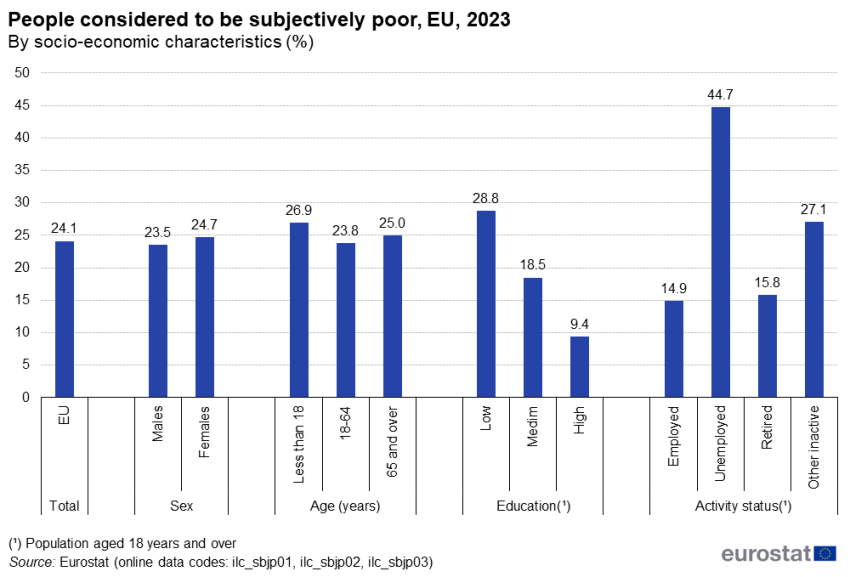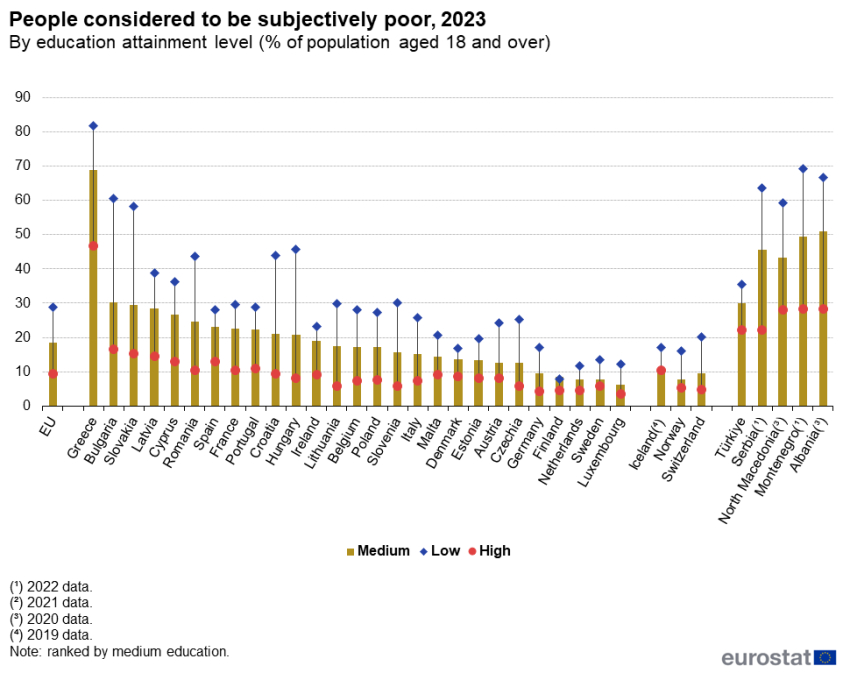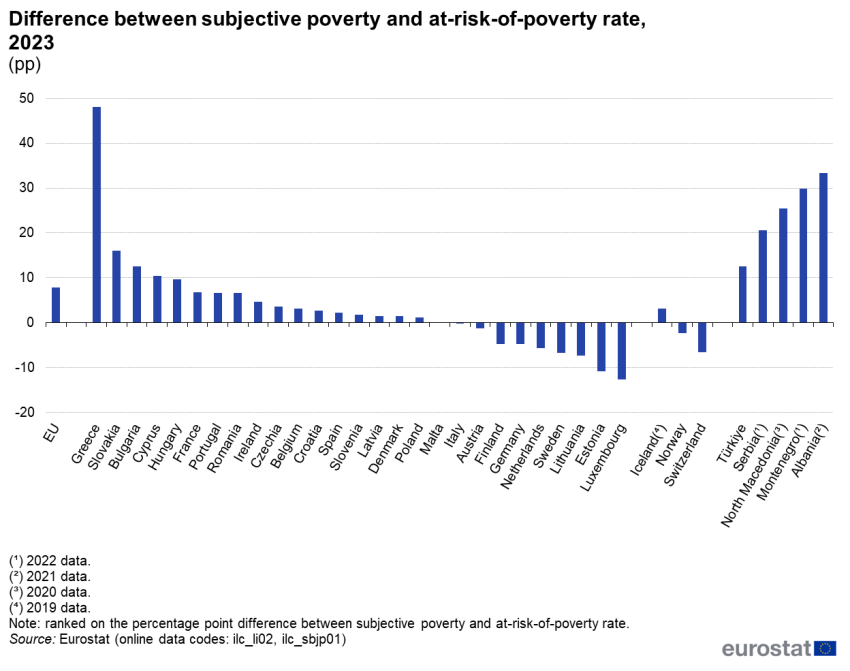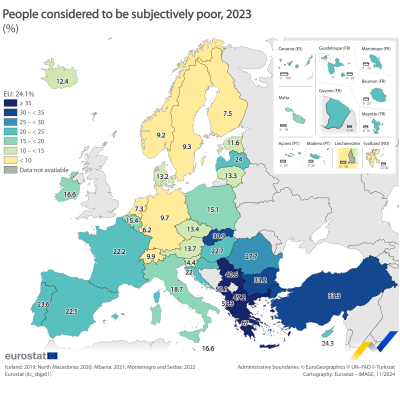Data extracted in October 2024.
Planned article update: 15 October 2025.
Highlights
In 2023, 24.1% of people in the EU were considered to be subjectively poor.
In 2023, in the EU, subjective poverty was three times higher among the population with a low level of education compared with those with a high level of education.
In 2023, the subjective poverty rate in the EU (24.1%) was 7.9 percentage points higher than the at-risk-of-poverty rate (16.2%).
This article focuses on the subjective poverty (see concept below) within the European Union (EU) in 2023. Values are presented at country level as well as among different demographic groups and by socio-economic characteristics.
All figures are based on EU statistics on income and living conditions (EU-SILC) available from Eurostat’s online database. EU-SILC data are available for all EU countries, as well as for most of the EFTA and candidate countries.

Source: Eurostat, (ilc_sbjp01) (ilc_sbjp02) (ilc_sbjp03)
Key findings
In 2023, 24.1% of people in the EU were considered to be subjectively poor. This percentage varied across different socio-economic groups:
- A slightly higher percentage of women (24.7%) were considered to be subjectively poor compared with men (23.5%).
- Young people under 18 had the highest rate of subjective poverty (26.9%), followed by those aged 65 and over (25.0%) and those aged 18–64 (23.8%).
- People with low education levels were most likely to be considered subjectively poor (28.8%), followed by those with medium education (18.5%). In contrast, this rate was only 9.4% for individuals with high education levels.
- Unemployed individuals were most likely to to be considered subjectively poor (44.7%), while other inactive persons also reported a high rate (27.1%). In contrast, subjective poverty was lower among retired persons (15.8%) and employed persons (14.9%).
- A higher percentage of people were considered to be subjectively poor (24.1%) compared to those at risk of poverty (16.2%). The largest gap was observed in Greece (48.1 pp), while the smallest or negative gaps were recorded in Luxembourg (-12.6 pp), Estonia (-10.9 pp) and Lithuania (-7.3 pp).
Subjective poverty is more prominent for women than for men
In 2023, 24.1% of people in the EU were considered to be subjectively poor (Figure 1), a slight decrease of 0.7 percentage points (pp) from 2022. The rate was 23.5% for men and 24.7% for women, with notable disparities observed among EU countries.
At national level, the lowest percentages of subjective poverty were observed in Luxembourg (6.2%), the Netherlands (7.3%) and Finland (7.5%), while the highest were seen in Greece (67.0%) and Bulgaria (33.2%). In 11 EU countries, more than 1 in 5 people were considered to be subjectively poor. The percentage of subjective poverty was higher for women than for men in all EU countries, except in Germany and Luxembourg, where it was slightly higher for men, by 0.4 and 0.1 pp, respectively.
Concerning age (Figure 2), subjective poverty in the EU in 2023 was generally highest among children (people aged less than 18) and lowest among working-age adults (18 to 64 years). However, in Estonia, Lithuania, Slovenia, Poland, Latvia, Romania, Croatia, Bulgaria and Greece, subjective poverty was highest among the older population (people aged 65 and over). Only in Luxembourg (6.8%) and the Netherlands (8.2%) reported the highest subjective poverty rates among working-age adults.
Subjective poverty is 3 times higher among people with low education levels compared with those with high education levels
The segmentation of subjective poverty by education is substantial. In 2023, almost one third (28.8%) of the EU population with a low educational attainment level (ISCED levels 0-2) were considered to be subjectively poor (Figure 3). This rate was 3 times lower (9.4%) among those with a high education (ISCED level 5-8). On the other hand, the percentage for people with a medium educational attainment level (ISCED level 3 and 4) was 18.5%, nearly twice as high as for those with high education levels.

Source: Eurostat (ilc_sbjp02)
Significant differences in subjective poverty rates were observed between high-educated and low-educated population groups across countries. The largest gaps were recorded in Bulgaria (43.9 pp), Slovakia (43.2 pp) and Hungary (37.8 pp), while the smallest gaps were in Finland (3.3 pp), the Netherlands (7.3 pp) and Sweden (7.7 pp). In 11 countries, the difference reached 20 pp or more. In Hungary and Slovenia, the subjective poverty rate among people with low education levels was more than 5 times higher than among those with high education levels (45.8% against 8.0% and 30.0% against 5.9%, respectively).
People considered to be subjectively poor outnumber those at risk of poverty in most EU countries
In 2023, the EU reported that higher shares of people were considered to be subjectively poor (24.1%) (Map 1) compared to people at risk of poverty (16.2%) (Map 2), a difference of 7.9 pp (Figure 4).
Higher levels of people considered to be subjectively poor were observed in Eastern and Southern Europe, with substantial differences between subjective poverty and at-risk-of-poverty rates. In total, 17 EU countries reported more people considered to be subjectively poor than at risk of poverty. Greece recorded the largest gap, with 67.0% of people considered to be subjectively poor compared with 18.9% at risk of poverty, a difference of 48.1 pp. Other countries with notable gaps included Slovakia (16.0 pp), Bulgaria (12.6 pp), Cyprus (10.4 pp) and Hungary (9.6 pp).
In Malta, subjective poverty and at-risk-of-poverty rates were equal, both at 16.6%, while in Italy, the gap was minimal at -0.2 pp, with subjective poverty (18.7%) nearly aligning with the at-risk-of-poverty rate (18.9%).
Moreover, Luxembourg recorded the largest negative gap, with 6.2% of people considered to be subjectively poor compared to 18.8% at risk of poverty, a difference of 12.6 pp. Other countries with notable negative gaps included Estonia (-10.9 pp), Lithuania (-7.3 pp) and Sweden (-6.8 pp). Smaller negative gaps were also reported in the Netherlands (-5.7 pp), Finland and Germany (both -4.7 pp).
Map 1: People considered to be subjectively poor, 2023 (%)
Source: Eurostat (ilc_sbjp01)Map 2: People at-risk-of-poverty, 2023 (%)
Source: Eurostat (ilc_li02)

Source: Eurostat (ilc_sbjp01) (ilc_li02)
Source data for tables and graphs
Data sources
The data used in this article are derived from EU-SILC. EU-SILC data are compiled annually and are the main source of statistics that measure income and living conditions in Europe; it is also the main source of information used to link different aspects relating to the quality of life of households and individuals. The reference population for the information presented in this article is private households and their current members residing in the territory of an EU Member State (or non-member country) at the time of data collection; persons living in collective households were excluded from the target population. The data for the EU are population-weighted averages of national data. The reference period for information on income is 2022, while the other households’ characteristics are referenced to 2023.
Context
Subjective poverty is a newly developed area with the idea of supplementing the well-known and traditional poverty indicators such as at-risk-of-poverty, material and social deprivation, people living in quasi-jobless households etc. Subjective poverty is a concept developed based on the EU-SILC variable ‘ability to make ends meet’. Contrary to the relative poverty measure, the at-risk-of poverty rate indicator (calculated based on the ranking of the households’ income at country level), the aim of subjective poverty is to assess the respondents’ perception of the difficulties experienced by the household in making ends meet. The assessment takes into account the households’ material wellbeing situation including income, expenditure, debt and wealth. The EU-SILC variable has 6 response categories:
- With great difficulty;
- With difficulty;
- With some difficulty;
- Fairly easy;
- Easily;
- Very easily.
Subjective poverty is defined on the basis of a combination of the top two categories of the variable. A household that answered “With great difficulty” or “With difficulty” is considered to fall under subjective poverty. This approach is more conservative than the approach based on the minimum income question (or lowest income to make ends meet). The minimum income question approach of subjective poverty was developed mid- 20th century, and it is a model based approach.
The at-risk-of-poverty rate is defined as the share of people with an equivalised disposable income (after social transfer) below the at-risk-of-poverty threshold, which is set at 60% of the national median equivalised disposable income after social transfers.
Used classification: Educational attainment level is classified according to ISCED — the international standard classification of education. The (latest) 2011 version has the following levels:
- ISCED level 0 — early childhood education;
- ISCED level 1 — primary education;
- ISCED level 2 — lower secondary education;
- ISCED level 3 — (upper) secondary education;
- ISCED level 4 — post-secondary non-tertiary education;
- ISCED level 5 — short-cycle tertiary education;
- ISCED level 6 — bachelor’s or equivalent level;
- ISCED level 7 — master’s or equivalent level;
- ISCED level 8 — doctoral or equivalent level.
Explore further
Other articles
Thematic section
Selected datasets
Methodology
Legislation
- Detailed list of legislative information on EU-SILC provisions for survey design, survey characteristics, data transmission and ad-hoc modules
- Regulation (EC) No 2019/1700 — the central piece of legislation for social surveys including EU-SILC
- Regulation (EC) No 2019/2242 — additional central piece of legislation for EU-SILC
- Summaries of EU Legislation: EU statistics on income and living conditions




